When I first broke the news to the rest of my coworkers that National Geographic would be flying me to Space Camp for the weekend, I was surprised to learn that my longtime friend and fellow Geeko writer Carolyn Cox had never heard of it. Ever! So if you’re like her, come on over and educate yourselves on the wonders of Space Camp.
Carolyn’s questions for me are in bold; my answers are in regular text.
I’ve realized whenever we say Space Camp, I’m just hearing ‘Dr. Spaceman” from 30 Rock in my head.
That’s okay, girl. Those are good instincts.
At what age would one attend Space Camp? Does everyone go to space camp, or only kids with an interest in science?
The youngest that you are allowed to be at the United States Space Camp is 7 years old, and you have to be accompanied by a legal guardian as a part of either a family trip or a day trip. Other than that, you have to be about 10 or older to be allowed to stay overnight at the camp on your own. This still seems way too young in my opinion, but I only ever went to an overnight camp once when I was 12 and shared a bunk with a girl who’d printed out at least 40 pages of Frodo/Sam slash fanfiction to read at night, so maybe my childhood memories of camp are a bit more risqué than is typical. There are a number of two day, three day, and weeklong groups for kids to stay overnight.
There are also several types of packages available for adults, of course, including a week-long “Space Academy for Educators” that involves 45 hours of continuing education credits, a “Corporate Camp” for team-building among coworkers, and a regular adult camp for grown-up nerds like us. The adult camp packages usually go for about three or four days. For the corporate ones, you can go anywhere from 1 to 5 days.
As far as I know you don’t need to be obsessed with science to go to Space Camp, but it is a pretty expensive trip for someone who doesn’t care about it at all. Space Camp is ultimately geared towards teaching kids about the space program regardless of their previously held level of knowledge, so if you go in with an open mind and a passion for learning, you’ll be set — there are a lot of different field trip options for just that type of kid, as a matter of fact. And if you’re not directly interested in the idea of space, there’s also a Robotics Camp for engineer-types and an “Aviation Challenge” camp for kids who want to be Air Force pilots.
Our crew trainers, Moriah Coxen and Nathan “Shaggy” Carter (Nathan gets a call sign because he also works at Aviation Challenge) told us that those Air Force kids over at Aviation Challenge can get really intense. As well they should be, because their camp ground basically looks like the set of Top Gun, complete with a beach volleyball court and an actual plane from the movie.
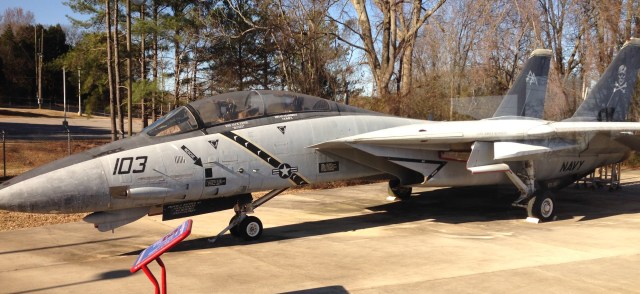
Danger zone.
Moriah and Shaggy were the best, by the way. Every time one of us gave them a phone or camera to take pictures with, they would also take one of themselves.
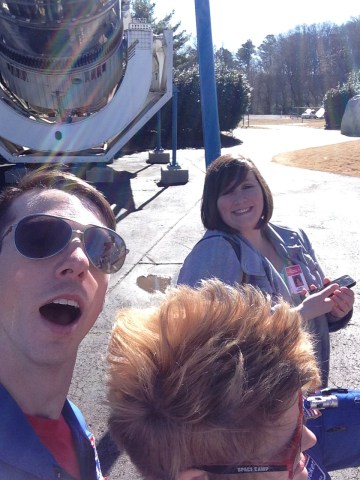
This was taken mere seconds before the above group picture.
Do you sleep at Space Camp?
There is a facility where the kids sleep at Space Camp when they go for overnight trips, but we stayed at the nearby Mariott instead. When I say nearby, I mean that you can literally see the camp from your window if you’re facing the right direction.
Do you do regular camp activities at Space Camp? Do kids throw up in an antigravity simulator?
Since we were only there for a day, our activities were a lot more crunched together than the average Space Camp experience. There are a number of team-building exercises, “simulated mission training” sessions, IMAX movies, museum trips, and rides that we unfortunately missed out on.
“Simulated mission training” is a whole part of the camp that’s devoted to pretending to be astronauts and mission control specialists. They have a number of different ISS station and Space Shuttle recreations, and your team has to assign themselves different roles, learn how to operate the part of the station that they’ve been assigned to, and then carry out that training together at the same time.
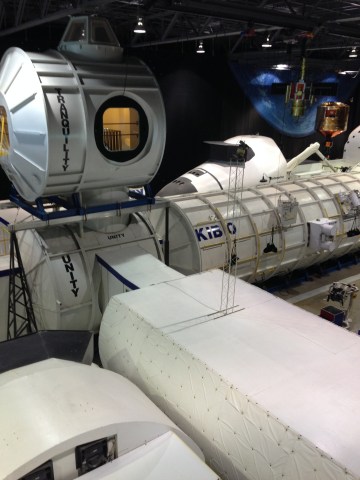
A view of the different modules, shuttles, and stations to play around in.
Because we’re not real astronauts and definitely didn’t know what we were doing, we were given a number of handy cheat sheets that told us exactly what to do for every situation. Even then, it was still difficult to line up what we were supposed to be doing with where the instructions for that task were actually located, and then actually finding all the right switches and buttons proved difficult sometimes as well. Turns out that pretending to be in space is surprisingly stressful.
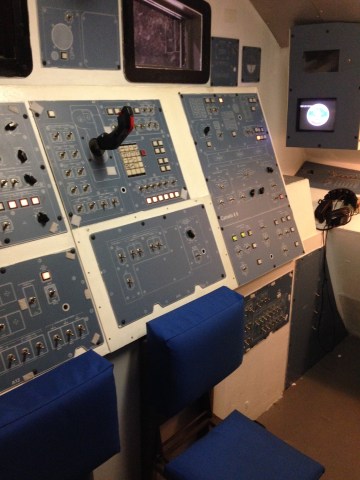
Interior of part of the Space Shuttle.
And then, of course, there was a crew at Mission Control who spoke to everyone in “space” over communications systems and helped to solve problems when they arose. And arise they did, because what’s the fun of going to Space Camp if you don’t get to also pretend that you’re in serious danger miles above the Earth’s surface?
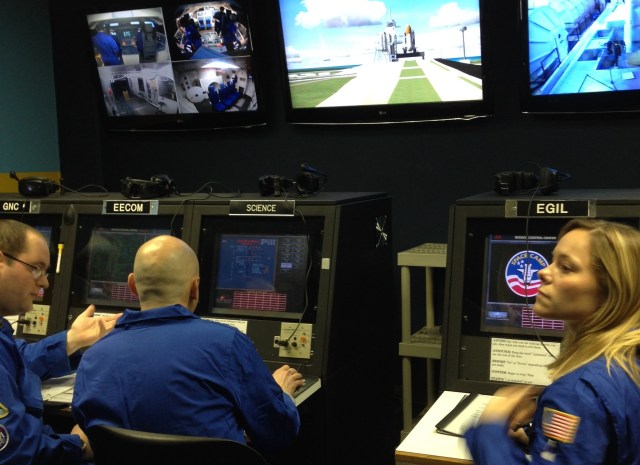
Chris Albert from National Geographic and Natalie DiBlasio from USA Today in the Mission Control room.
As a “field engineer,” I was assigned to the Zarya module aboard the ISS. Our job was to perform a bunch of cutesy science experiments (but of course we just gave each other Rorshach tests and spun around on the mechanized chair in our module) while simultaneously making sure the ISS didn’t accidentally fall out of the sky.
Of course, we learned how to do our jobs before lunch and didn’t get to the mission until after dinner, so we might have forgotten a lot of our training. Luckily we didn’t actually crash to Earth, and our entire Space Camp class made it out relatively okay. You know, except for the two people assigned to the exterior of the Space Shuttle who didn’t make it back inside before it landed, but whateeeveeer, am I right, guys? We still graduated from Space Camp, so it’s all good.
Rocket construction is also a big part of the camp experience, which is to be expected. Our trainers had special pre-made sets for us to put together with Elmer’s glue, which were made of cardboard, plastic, and string.
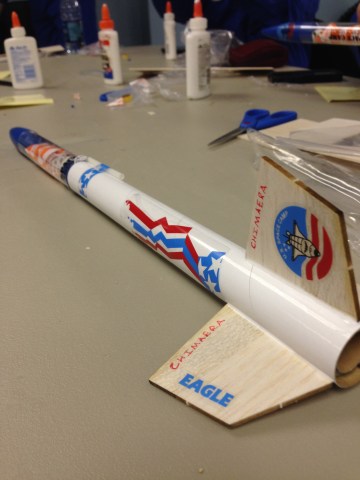
Yes I did name my rocket after the Imperial Star Destroyer from Heir to the Empire. What?
Later in the afternoon we went to an open field and launched the rockets on a special pad using model rocket engines (they look like small fireworks) that were placed in the tail end of the rocket. The plastic part would disconnect from the cardboard part and allow a small parachute to open up, allowing the rocket to safety land — usually into a tree.
Yes, they had us behind a blast shield. The rockets almost hit us a bunch of times anyway.
As for the throwing up thing, there aren’t actually any hugely intense astronaut training simulators at the camp — no vomit comets or giant spinning arms or anything like that. Here’s what we were allowed to play with when we were there:
This is the MAT, or “Multi-Axis Trainer,” which intentionally causes disorientation in its passenger that is similar to the type one might experience in a tumble-spin upon reentry into Earth’s atmosphere. The MAT itself was never used in any kind of astronaut training, but it was inspired by the MASTIF (Multiple-Axis Spin/Space Test Inertia Facility), which was used by astronauts preparing for the Mercury program. The MASTIF (and the MAT in Space Camp) both have joysticks; the actual one that you get to ride in real-life Space Camp does not.
Shaggy and Moriah (who you can see in the video on the right: bonus points if you can make out Moriah’s sonic screwdriver in her left arm pocket) were adamant that most people don’t actually get nauseous in this thing, as your stomach stays in relatively the same position the whole time. It can definitely mess with your inner ear, though, because that’s what it’s supposed to do. I know I needed a five minute break after getting off to nurse a wicked headache, but nobody seemed to experience any side effects that were too terrible. Heck, one of us even went on it twice.
There’s also a springy chair that simulates 1/6 gravity, which is the same amount of gravity you’d experience on the Moon. Basically, you get in it and you pretend you’re walking on the moon. This was my favorite of all the simulators, because I got to kick my legs back and forth like I was doing a really intense flying Crouching Tiger move.
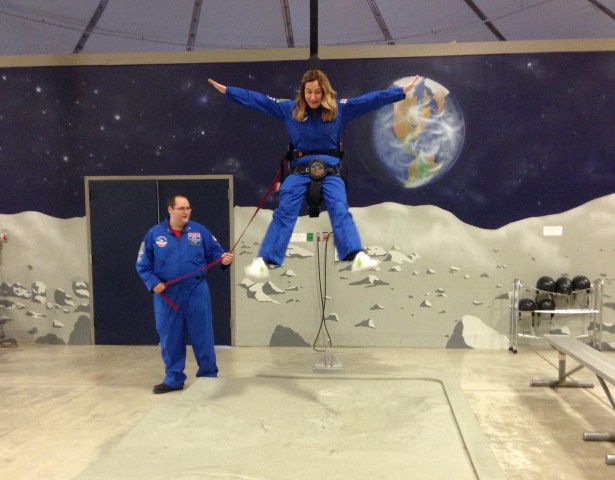
Melike Karakartal for Hurriyet on the 1/6 gravity chair.
Then there was the MMU, or “Manned Maneuvering Unit,” which you might remember from the film Gravity. Obviously the MMU at Space Camp isn’t as cool a jetpack as the real thing because it’s still being subjected to Earth’s gravity and can’t really maneuver in every direction, but it’s still pretty fun to turn yourself at a 90 degree angle and swoop around.
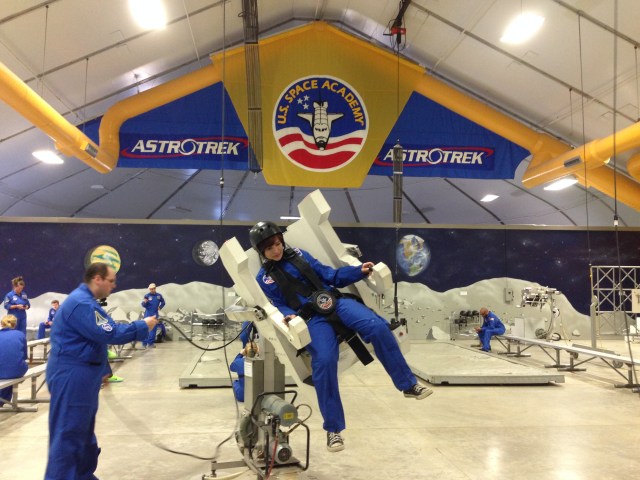
Me trying to use the MMU. I was not very good at landing.
Finally, to simulate weightlessness and get some hands-on experience with different levels of pressure on our bodies, we got the chance to go scuba-diving at a 24-foot deep UAT (Underwater Astronaut Training) pool on the premises. There was definitely an adjustment period for those of us who had never scuba’d, but once we got down there it was fun to swim around and interact with the toys and objects they had in the pool. For example, there’s a bowling ball that you can dunk into a basketball net with fairly minimal effort, and a larger 100lb ball that you can throw around like nothing. There’s also a bunch of portholes that you can use to look out onto the rest of the facility and wave at little kids who walk by.
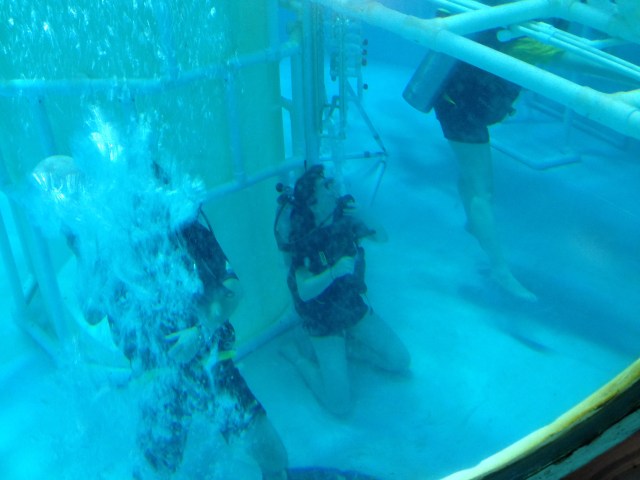
Here you see me doing very important scientific research. Namely, trying to find where the little rubber pool torpedo I just threw landed. Very important science.
Of course, there were some standard space-themed amusement rides as well, and I bet kids probably throw up on them all the time.
How did “Space Camp” as a concept originate?
The U.S. Space & Rocket Center, which is the museum around which Huntsville’s Space Camp is based, has actually been around since 1970. The actual Space Camp itself was first launched in 1982, and — okay, brace yourselves for some complicated feelings — was originally conceived of by Dr. Wernher von Braun, the former director of the nearby NASA Marshall Space Flight Center. If that name sounds vaguely familiar, it’s because von Braun was one of the Nazi Party-affiliated German rocket scientists who got snatched up by NASA after World War II. Which, okay, that sounds bad, especially when you consider how good the Nazis were at inspiring their young people and how that’s maybe sort of not-unlike what Space Camp is trying to do. But trust me when I tell you that there’s nothing about the camp itself that feels indoctrinating or uncomfortable in any way. It’s just a bunch of really cool people trying to teach kids about space.
How accurate is Space Camp the film?
Probably not very. I admittedly have not seen it, but I’m also reasonably certain that no one is stupid enough to actually let a bunch of kids on board a rocket right before launching it. Heck, they wouldn’t even let the kids go near the scuba equipment.
[Editorial Note – Glen here. Having seen Space Camp a number of times as a kid (but not since) I can weigh in on this. Space Camp is bananas. At no point during actual Space Camp are cadets in any danger of being accidentally shot into space.]
Are there any other references in pop culture to Space Camp?
Surprisingly, yes! There’s a Hallmark movie that was actually filmed at the Huntsville Space Camp and released in 2012. It’s called A Smile As Big As The Moon and it’s based on a 2002 memoir by this teacher who took special education students (who were played by actual special needs child actors in the movie) to Space Camp. They have a giant wall full of still images, costumes and props from the film, and a small television screen that appears to be playing the film near-constantly.
I also found that one of the costumed mannequins looked astonishingly like Leslie Knope.
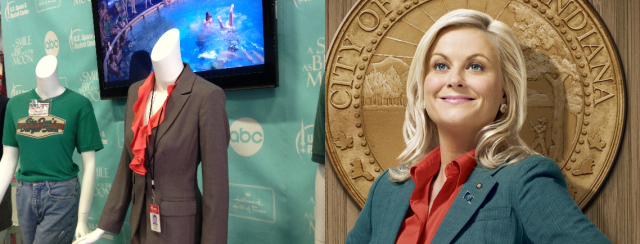
C’mon. Tell me you don’t see it. (R. photo credit: NBC)
Did any astronauts go to Space Camp?
A lot of astronauts are trained as air force pilots first, so if they were going to go to any kind of camp it would probably be Aviation Challenge next door. However, there are a few astronauts and ISS engineers who went to Space Camp as kids, which Space Camp recognizes in their Hall of Fame. The very first Space Camp alumna to ever actually go into space was Dottie Metcalf-Lindenburger, who went up in 2010 as a Mission Specialist on a space shuttle bound for the ISS. So it’s not exactly something that happens very often (United States Space Camp was only founded in 1982, after all), but it’s absolutely possible, and will probably be even more common in the future as the camp grows.
What aspects of the American collective consciousness am I missing out on from not knowing what this Space Camp is?
While it’s true that the United States’ national identity has certainly been more focused the idea of space travel for much longer than most other nations, Space Camp actually sees a surprising number of international tourists as well as American ones. Moriah told us that she’d recently lead a tour of kids from London who were just as excited to be at Space Camp as they were by her awesome sonic screwdriver (it was Ten’s, by the way, so double awesome there). And while most of the people who work at Space Camp are American, one of our other crew trainers was Canadian, and her personal mission was to get us excited about the dinky whoops I totally mean very useful and important Shuttle Remote Manipulator System (SRMS, AKA the Canadarm) on the Space Shuttle.
But I know that personally, I didn’t walk out of Space Camp feeling anything like national pride, despite the fact that most of the museum exhibits we saw focused on American astronauts. I was much more invested in thinking about the collective achievements of humanity and how we’ve been able to come together as a species through our shared fascination with what lies beyond our atmosphere. And I definitely had a much stronger appreciation for the bravery, intelligence, and coolness of the people who really have been up in space. Not being able to push the right buttons at the right moment for twenty some-odd minutes was enough to stress me out immensely, and I was still on the ground breathing normal unfiltered air and everything.
Where can I learn more about this idea of a “Space Camp?”
If you’re interested in learning more about Space Camp or even figuring out how to go to the camp yourself, then you can check out their official website for more information, as well as rates for different kid and adult packages. It is admittedly pretty expensive, though I can’t speak to whether or not it costs more or less than your average vacation because I live in a city where sandwiches sometimes cost $10, so my gauge of what constitutes a fair price for something has been irreparably damaged (You should have seen me at the hotel bar doing the math on those cocktail prices, y’all. Mind blown).
I will say that if you’re one of those types of people who loves being busy on vacations and has an interest in science and learning to begin with, then you will absolutely adore Space Camp. I had an amazing time, and I don’t think there was a single person in my “class” who didn’t walk out of there immediately wishing they could go back.
(images my own unless otherwise indicated)
- We talk at length about Space Camp on our most recent podcast episode
- Here are some more pictures of Space Camp from the Geekosystem Instagram
- Check out the latest trailer for Neil Degrasse Tyson’s Cosmos reboot








Published: Feb 25, 2014 02:52 pm